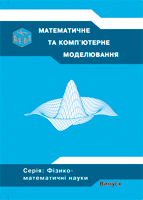Центральність у складних мережах та посередництво у мережевих системах
DOI:
https://doi.org/10.32626/2308-5878.2019-19.118-124Анотація
Аналізуються концепції центральності та впливу вузлів складних мереж для визначення їх важливості у структурі системи. Вводяться поняття міри, області та потужності посередництва вузлів та ребер мережі для ідентифікації їх важливості у процесі функціонування мережевих систем. Ці показники кількісно виражають ступінь сприяння відповідного елемента рухові потоків у системі та визначають втрати, які її очікують у разі блокування цього вузла або ребра чи цілеспрямованої атаки на нього. Аналогічні поняття посередництва вводяться для визначення функціональної важливості окремих підсистем мережевих систем. Наводяться приклади практичного застосування отриманих результатівПосилання
Bonacich P. Power and Centrality: A Family of Measures. American Journal of Sociology. 1987. Vol. 92 (5). P. 1170–1182.
Borgatti S. P. Centrality and network flow. Social Networks. 2005. Vol. 27 (1). P. 55–71.
Freeman L. C. Centrality in social networks conceptual clarification. Social net-works. 1979. Vol. 1 (3). P. 215–239.
Bavelas A. Communication patterns in task-oriented groups. Journal of American Acoustic Society. 1950. Vol. 22 (6). P. 725–730.
Freeman L. C. A set of measures of centrality based upon betweenness. Sociometry. 1977. Vol. 40. P. 35–41.
Piraveenan M. Percolation Centrality: Quantifying Graph-Theoretic Impact of Nodes during Percolation in Networks. PLOS ONE. 2013. Vol. 8 (1). e53095.
Faghani M., Nguyen U. T. A Study of XSS Worm Propagation and Detection Mechanisms in Online Social Networks. IEEE Trans. Inf. Forensics and Securi-ty. 2013. Vol. 8 (11). P. 1815–1826.
Katz L. A New Status Index Derived from Sociometric Index. Psy¬chometrika. 1953. Vol. 18 (1). P. 39–43.
Bonacich P., Lloyd P. Eigenvector-like measures of centrality for asymmetric relations. Social Networks. 2001. Vol. 23 (3). P. 191–201.
Marchiori M., Latora V. Harmony in the small-world. Physica A: Statistical Mechanics and its Applications. 2000. Vol. 285 (3–4). P. 539–546.
Krackhardt D. Assessing the Political Landscape: Structure, Cogni¬tion, and Power in Organizations. Administrative Science Quarterly. 1990. Vol. 35 (2). P. 342–369.
Glenn L. Understanding the influence of all nodes in a network. Scientific Re-ports. 2015. Vol. 5. 8665.
Polishchuk O. Flow Models of Complex Network Systems. Intern. Scientific-Practical Conf. on Problems of Infocommunications. Science and Technology. 2018. P. 317–322.
Polishchuk O., Polishchuk D. Monitoring of flow in transport networks with partially ordered motion. ХХІІІ Conf. Carpenko physics and mechanics institute, NASU. 2013. P. 326–329.
Polishchuk D., Polishchuk O., Yadzhak M. About complex evaluation of hierar-chically-network systems. IVth Conf. «Knowledge — Ontolo¬gy — Theory». 2013. P.68–79.
##submission.downloads##
Опубліковано
Номер
Розділ
Ліцензія
Authors who publish with this journal agree to the following terms:- Authors retain copyright and grant the journal right of first publication with the work simultaneously licensed under a Creative Commons Attribution License that allows others to share the work with an acknowledgement of the work's authorship and initial publication in this journal.
- Authors are able to enter into separate, additional contractual arrangements for the non-exclusive distribution of the journal's published version of the work (e.g., post it to an institutional repository or publish it in a book), with an acknowledgement of its initial publication in this journal.
- Authors are permitted and encouraged to post their work online (e.g., in institutional repositories or on their website) prior to and during the submission process, as it can lead to productive exchanges, as well as earlier and greater citation of published work (See The Effect of Open Access).

